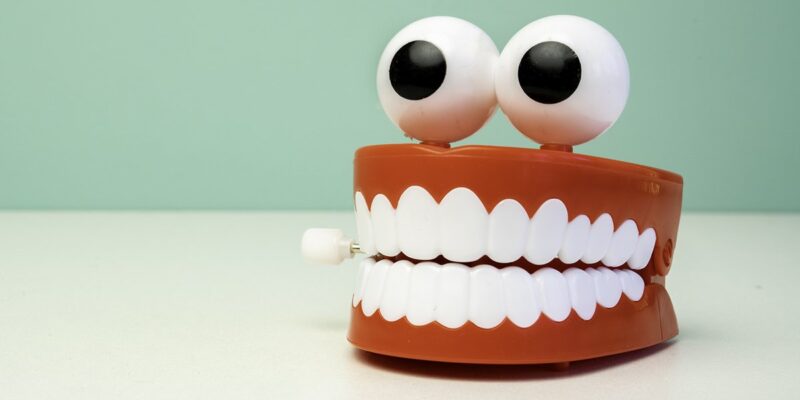– Dr. Deepa Ravichandran M.D.S.
What exactly is a Deprogrammers in dentistry?
Deprogrammers are generally used to eliminate muscle tension, pain or discomfort and allow muscles to relax. When muscles are in relaxed state, the mandible relates to the maxilla in a fully seated position and during movements, mandible moves in a smooth glide without interferences i.e., what is being referred to here, is centric relation (CR).
Maximum intercuspation position (MIP) is, as the name suggests, the maximum occlusal relationship between contacting surfaces of teeth. In some patients, CR is equal to MIP. But in most cases, due to occlusal interferences, CR is not equal to MIP. This is when we say that a ‘CR-MIP discrepancy’ exists in the patient. That is when a deprogrammer comes into play.
When to deprogram?
We end up needing to deprogram certain patients, because they do not have a smooth, uninterrupted glide, from the position of CR to the position of MIP, due to occlusal interferences. This is akin to one cruising along on an empty road only to be rudely awakened by a very steep speedbreaker! Such patients typically have complaints of pain in the joint.
But there is another category of patients – the silent ones. They too end up having pathologic occlusal interferences preventing a smooth glidepath from CR to MIP. But in this case, there is no pain whatsoever. Rather, their muscles get adapted to a habitual CR, but it’s at the expense of either their natural teeth or any prosthesis in their mouth. Their natural teeth get worn, leading to a collapsed VD or their prosthesis fractures.
Now some of these patients require a full mouth rehab, some don’t. But the point is, they do need to be deprogrammed, and shifted from their habitual MIP to their true MIP. There are many ways to achieve that, through various anterior and posterior appliances and we call them ‘deprogrammers’.
Practical issues with commercially available/lab made deprogrammers – and a possible solution
A deprogrammer is a separate and extra appliance, usually rigid, that the patient must wear for an extended period of time, and for which, in most practices they are billed for. This adds to the financial burden in some cases because fixed prosthetic work is not exactly cheap.
Add to that, we sometimes have an issue with patient compliance, either because they are not comfortable or don’t want to wear it. This puts both the clinician and the patient in a dilemma, for unfortunately, without being deprogrammed, the clinician cannot proceed forward, and the insistence on wearing the appliance by the clinician, makes the patient not want to proceed forward with the treatment.
To overcome the above two obstacles, in my practice, I have tried to use something which is already a part of the treatment, and I have found great results, although I do occasionally use a soft splint to achieve the same, depending on the case. I’ve observed that patient compliance to soft splints, for limited hours, at night is definitely better than a hard appliance for 24 hours. Below I will be showing the three different deprogrammers used by me, in three different cases. Since this article is covering only deprogrammers in dentistry, the focus would be only on that, and not on the entire case as a whole.
Case 1 – Using temporary acrylic prosthesis
A newly married lady in her late twenties approached my operatory, with severe pain in 47. On examination, she had a PFM FPD on 45, 46 and 47. Unfortunately the FPD had a fracture on 47, associated with pain.
There is usually only one reason for an FPD to fracture and that is, fabrication in the wrong bite.
Once the fractured FPD was removed, the cause of the pain was obvious – caries on the distal of 47 approaching the pulp. The pain was taken care of by performing endo on 47, but fabricating a new prosthesis at the correct bite, was a whole different story.




Case 2 – Using composite buildup
A 66-year-old gentleman walked into the operatory, requesting replacement of a fractured PFM crown on 47. There was a history of a fracture on the same crown two years earlier too. The present fracture is the second time it is taking place.
Repeated occlusal fracture of crown or dislodgement is suggestive of lack of adequate interocclusal clearance.
Additionally, he had a midline shift to the right, clearly indicating this was not a case of single crown replacement.



Case 3 – Using soft splint
A 21-year-old young lady walked into the operatory with the chief complaint – uneven front teeth, which hampered her confidence. She was ashamed to smile and often covered her mouth while smiling. She had a history of orthodontic treatment since the last 3 years, done elsewhere. She was not happy with it, and now wished to de-bond as she was unhappy with her dental esthetics. She also complained of very severe pain and sensitivity in all her front teeth.
The pain was so severe, she was unable to eat properly, mainly because her lower front teeth were “banging” with her upper front teeth, every time she ate or spoke. Obviously, this meant that restoring her functional anterior occlusion was of paramount importance.
We decided to de-bond as, she was pretty firm about it, and also with the brackets still on her teeth, it was not possible to visualize the corrections needed.

Anterior guidance is the the dynamic relationship of the lower anterior teeth against the upper anterior teeth through all the ranges of function. As evident from the pre-op image, this patient had an improper anterior guidance, leading to trauma from occlusion (‘banging’ as complained by the patient). Although her anterior guidance was restored with crowns, it was still shallow (because she was a case of horizontal growth). Thus, her anterior guidance was not steep enough to prevent her from clenching, and so the crowns alone were not enough to deprogram the patient, in this particular case. This is why the patient was given a soft splint additionally, both to eliminate clenching due to muscle memory as well as due to force of habit. Hence, here the soft splint in essence acted as a deprogrammer.


Conclusion
I would like to conclude by saying that the “use what we have approach” to deprogramming in clinical practice is as effective as any of the traditional deprogrammers in dentistry, without the burden of added financial cost to the patient and the headache of patient compliance for the clinician. Often there are many roads which lead us to the same destination, and it is upto us as clinicians to decide which road is more suitable for the patient to embark on their journey of functional rehabilitation.
Hard Versus Soft Splints – Which is better?
When not to use deprogrammers?
References
- Angle Orthod. 1999 Apr;69(2):117-24; discussion 124-5. The use of a deprogramming appliance to obtain centric relation records. Karl PJ, Foley TF.
- Am J Orthod Dentofacial Orthop. 2006 May;129(5):619-30. Three-dimensional analysis of models articulated in the seated condylar position from a deprogrammed asymptomatic population: a prospective study. Part 1. Cordray FE.
- J Prosthet Dent. 1988 May;59(5):611-7. Simple application of anterior jig or leaf gauge in routine clinical practice. Carroll WJ, Woelfel JB, Huffman RW. Department of Restorative and Prosthetic Dentistry, Ohio State University, College of Dentistry, Columbus.
- Dent Clin North Am. 2012 Apr;56(2):387-413. doi: 10.1016/j.cden.2012.01.003. Sleep bruxism: a comprehensive overview for the dental clinician interested in sleep medicine.
Carra MC, Huynh N, Lavigne G. - Eur J Prosthodont Restor Dent. 2004 Sep;12(3):125-8. Reliability of a measuring-procedure to locate a muscle-determined centric relation position. Zonnenberg AJ, Mulder J, Sulkers HR, Cabri R.

















So what guides how long one should deprogramme?
Sanjay Arora Usually it’s 15-30 days on average. But it really depends on each patient and how long it takes to resolve their symptoms. For eg, in my case with composites and the soft splint it was almost immediate. In the case with pmma, it took 10 days.